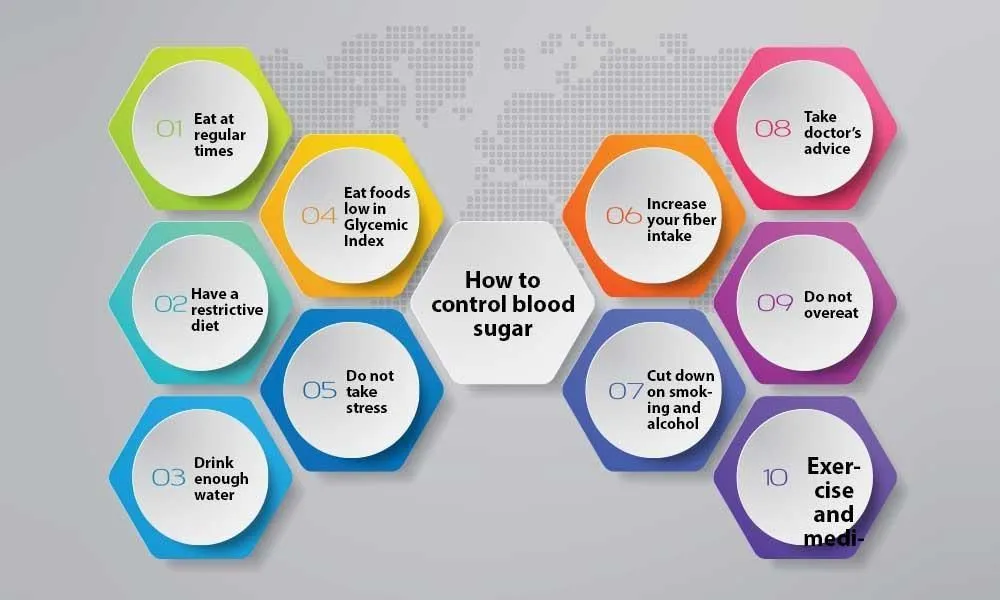Diabetes is a chronic disease that occurs when the pancreas cannot make enough insulin to carry out daily activities, or when the body itself cannot use the insulin produced. Both these situations can raise blood sugar levels and cause various health issues.
Diabetes is dangerous and is one of the most popular illnesses in the world. What makes it worse is that it affects every part of the body, and can lead to failure of the heart, kidneys, and liver. Sometimes a person may even go into a coma because of it.
Here are the symptoms of increased or lowered levels of glucose in the blood:
Irregular sleep patterns
Weakness
Desire to eat sweet foods
Irregular bowel movements
Too much hunger and thirst
Gaining or losing weight rapidly
Weakening eyesight
Numbness
Reduced healing factor
The first thing to note about increased or lowered blood sugar levels (hyperglycemia or hypoglycemia) is that they could also be hereditary, and then there isn’t much you can do about it. You could only live with restricted eating and drinking choices, and adopting a fitness-centric lifestyle.
Exercising and meditating can help you reduce your chances of inheriting this disease from your parents, though nothing can make it zero. Here are some ways that you can do to control diabetes:
1.Eat at regular times
2.Have a restrictive diet
3.Drink enough water
4.Eat foods low in Glycemic Index
5.Do not take stress
6.Increase your fiber intake
7.Cut down on smoking and alcohol
8.Take doctor’s advice
9.Do not overeat
10.Exercise and meditate
Anything that can cause a spike in your blood sugar or insulin levels can invite a risk. So you should stay away not just from fast foods or soft drinks, you should also stay away from fatty and oily foods, and foods that are rich in polysaturated or trans fats. You should also work out every day and stay away from consuming alcohol.
There are four types of diabetes:
1.Gestational diabetes
2.Prediabetes
3.Type 1
4.Type 2
Among them, Type-2 Diabetes is the more commonly found variant of this insulin-related disease. Monitoring blood sugar levels is extremely important for its proper diagnosis and treatment. It is just as important to inform your healthcare specialist about any change in symptoms as mentioned above.
You may note that insulin imbalance may also cause irregular weight gain or loss. It is important to stick to a restrictive diet to maintain the flow of glucose in the bloodstream. Since most of the biological functions in our bodies are related to our metabolism rate, it is important to eat foods rich in fiber.
1.French fries
2.Refined carbohydrates
3.Breakfast cereals
4.Sugar-sweetened beverages
5.Sweets
6.Chocolates
7.Trans-fats
8.White bread, rice,
9.Fast foods like pasta and pizza
10.Fruit-flavored yogurt
11.Dried fruit
12.Honey
13.Maple syrup
14.Sweetened breakfast cereals
15.Flavored coffee drinks
16.Agave nectar
One should also stay away from smoking and consuming alcohol. We also recommend that you include fiber-rich foods to keep your metabolism in top shape, and we are discussing some of them in detail. This nutrient would also help you address your weight management issues.
Adding more fiber to your diet is perhaps the best way to lose weight and belly. It improves the functioning of your heart and prevents the risk of many diseases such as diabetes, cancer, and osteoporosis. Including fibrous foods in your daily diet cleans up the waste materials in our food and they are then flushed out, thus keeping our intestines in top shape.
It also keeps us away from diabetes because the sugary substances that are usually found clinging to the insides of our intestines are also swept out by this nutrient. This reduces the risks of surges in blood sugar levels. Steady and proper insulin levels will keep you safe from all the symptoms of diabetes.
This is both easy and delicious. You can find fiber in almost all whole grains such as brown rice and quinoa. High-fiber cereals and oatmeal are great sources of fiber and can be combined with other high-fiber sources such as berries and bananas.
Foods rich in fiber often have extremely low calories and are super filling so you’ll end up having less anyway. Whole fruits and vegetables, nuts and seeds, berries, bananas, banana muffins, dried fruit, hummus are great options for a healthy snack.
A salad made with a combination of nuts, kidney beans, chickpeas, seeds, or crunchy vegetables is a great way of having more fiber for lunch. Brown rice, lentils and mushrooms, or chicken is another great lunch idea!
If you've recently been diagnosed with Type-2 Diabetes, you'd probably be feeling overwhelmed. If you've lived with the condition for some years, you know what the struggle it is- you may be overweight or obese, and you may not have exercised in years.
The thought of plunging into a workout routine may seem intimidating but attaining gradual weight loss is a natural and healthy way to lower blood sugar. Obesity and diabetes are closely interrelated, and weight loss may get you off the insulin and could even "cure" the disease.
Also read: How Do Artificial Sweeteners Influence Weight Loss | MevoLife
1.Excess weight may cause diabetes and medicines can also result in weight gain. Even if the odds are stacked against you, you should make a full-scale effort to drop the extra pounds. We recommend that you contact a fitness trainer online and start working at your place.
2.Studies have conclusively shown that intensive lifestyle interventions, including weight loss, decrease the overall risk of diabetes by 58%. According to a study published in Annals of Internal Medicine, an increase in Body Mass Index (BMI) is the most important factor contributing to the increase in this insulin-related disease.
3.Losing just 5-10% of body weight can significantly reduce blood sugar among overweight people. Dropping as little as 10 to 15 lbs. of weight is proven to not only lower blood sugar, but also reduce cholesterol, bring down blood pressure, and decrease stress on joints, resulting in better sleep, better energy, better fitness, and better overall health.
4.Significant weight loss (more than 100 lbs.) conclusively decreases Type-2 Diabetes from 27% to 9% after 6 years. The earlier in the course of the disease weight loss is instituted, the more effective it is likely to be. Staying fit and active, eating a healthy well-balanced diet, and ideal body weight makes it easier to control blood sugar.
Research has shown that people who have a family history of Type-2 Diabetes are more likely to develop the condition themselves. Weight loss is critical in these people because a healthy weight (BMI 25 or lower) reduces their chances of getting diabetes by up to 90%.
The Diabetes Prevention Program, a major study of more than 3000 patients showed that moderate diet and exercise of about 30 minutes or more, 5 or more days per week, resulting in a 5%-7% weight loss could delay and possibly even prevent Type-2 Diabetes.
Weight loss helps control diabetes in two important ways. First, it lowers insulin resistance and allows natural insulin to work better at lowering blood sugar levels. Losing weight brings down blood sugar levels and this may result in a reduction in diabetes medication or stopping it altogether. Second, it improves cholesterol and blood pressure levels and reduces the risk of heart disease.
Tip: Ever wondered if you could lose weight by cutting out sugar from your diet could make a difference?
A rapid weight gain or loss experience is a sign of how hard you need to get your diabetes under control. Not only would this prevent some life-threatening complications, but it would also keep you motivated to adopt healthier changes. You should start with a weight loss program after discussing it with your fitness and healthcare experts.
It is best to set realistic weight loss goals, aim for moderation, and eat a healthy diet in combination with physical activity to achieve those goals. Instead of being a spectator to your health, you should follow your doctor’s advice and stay cautious about your dietary habits.
Eating a healthy diet, consisting of protein and fiber foods, would help you get started on the right note, and the best time to get started with anything good is always today. We hope you get on your fitness program sooner than ever and say bye-bye to diabetes and beat excess weight along with it too!



